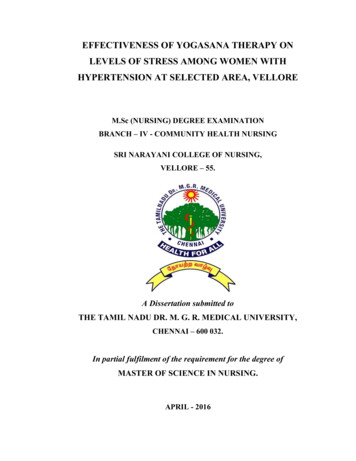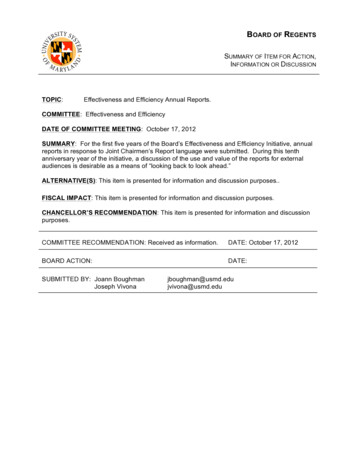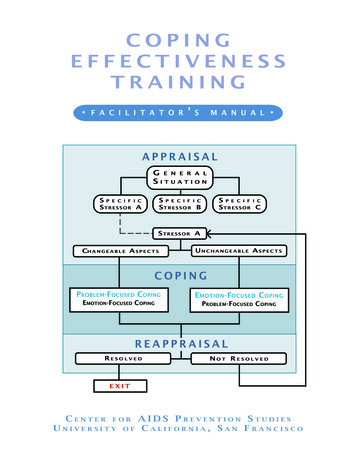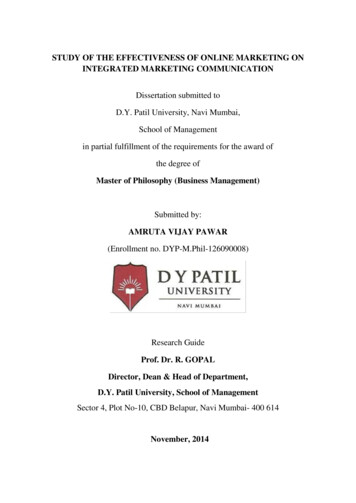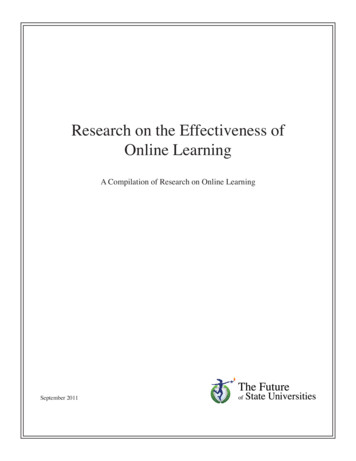
Transcription
Research on the Effectiveness ofOnline LearningA Compilation of Research on Online LearningSeptember 2011
Table of ContentsI.Learning Outcomes . 1II.Growth of Online Learning . 8III.Cost of Online Learning . 17IV.Impact on Instructional Design and Delivery. 24
Learning OutcomesComparative research on learning outcomes in distance education versus face-to-faceinstructional settings has a long history, reaching back to the 1920s. The findings of hundreds,perhaps thousands of studies, over the decades and through the 1990s have been consistent there are no significant differences in learning outcomes achieved by students engaged in faceto-face instruction compared to those participating in distance education. This holds trueregardless of the technology medium used, the discipline, or the type of student. Beginningaround 2000, several studies, including meta-studies (review and analysis of hundreds of studiesselected for their rigor), began to find significant differences in favor of online learning. Thesestudies culminated in 2010 with a report from the U.S. Department of Education “Meta-Analysisand Review of Online Learning Studies.”U.S. Department of Education. (2010). Evaluation of Evidence-Based Practices in OnlineLearning: A Meta-Analysis and Review of Online Learning ence-based-practices/finalreport.pdf―A systematic search of the research literature from 1996 through July 2008 identified more thana thousand empirical studies of online learning. Analysts screened these studies to find those thata) contrasted an online to a face-to-face condition, b) measured student learning outcomes, c)used a rigorous research design, and d) provided adequate information to calculate an effectsize.‖―Earlier studies of distance learning concluded that these technologies were not significantlydifferent from regular classroom learning in terms of effectiveness. Policymakers reasoned that ifonline instruction is no worse than traditional instruction in terms of student outcomes, thenonline education initiatives could be justified on the basis of cost efficiency or need to provideaccess to learners in settings where face-to-face instruction is not feasible.‖Moreover, with the advances in Web-based and collaborative technologies which are a ―far cry‖from earlier distance education applications, ―Policy-makers and practitioners want to knowabout the effectiveness of Internet-based, interactive online learning approaches and needinformation about the conditions under which online learning is effective.‖Key findings: Students who took all or part of their course online performed better, on average, thanthose taking the same course through traditional face-to-face instruction. Effect sizes were larger for studies in which the online instruction was collaborative orinstructor-directed than in those studies where online learners worked independently.1
Most of the variations in the way in which different studies implemented online learningdid not affect student learning outcomes significantly. The effectiveness of online learning approaches appears quite broad across differentcontent and learner types.A further review of experimental and quasi-experimental studies that contrasted different typesof online learning practices found the following: When a study contrasts blended and purely online conditions, student learning is usuallycomparable across the two. Elements such as video or online quizzes do not appear to influence the amount thatstudents learn in online classes. Online learning can be enhanced by giving learners control of their interactions withmedia and prompting learner reflection. When groups of students are learning together online, support mechanisms such asguiding questions generally influence the way students interact, but not the amount theylearn.Shachar M., & Neumann, Y., (2010). Twenty Years of Research on the AcademicPerformance Differences Between Traditional and Distance Learning: Summative MetaAnalysis and Trend Examination, MERLOT Journal of Online Learning and Teaching, Vol.6, No. 2. http://jolt.merlot.org/vol6no2/shachar 0610.pdf―This meta-analysis research estimated and compared the differences between the academicperformance of students enrolled in distance education courses, relative to those enrolled intraditional settings, as demonstrated by their final course grades/scores, within the last twentyyear (1990-2009) period, further broken down to four distinct sub-periods.‖A large k-125 of experimental and quasi-experimental studies met the established inclusioncriteria for the meta-analysis (including data from over 20,000 participating students), andprovided effect sizes, clearly demonstrating that in 70 percent of the cases, students takingcourses by distance education outperformed their student counterparts in the traditionallyinstructed courses. By dividing the two-decade time span into four sub-studies, it was determinedthat the probability of DE [Distance Education] outperforming F2F [Face-to-Face] increasedfrom 1991–2009 and authors predict that it will continue to increase in strength.Criteria for including studies in the review included the time period covered, the quality of thestudy, the inclusion of a control or comparison group, and sufficient quantitative data for the twogroups to be analyzed. Studies in English, German, French, Spanish and Italian languages wereincluded.2
Schachar, M., & Neumann, Y., (2003). Differences Between Traditional and DistanceEducation Academic Performances: A meta-analytic approach, The International Reviewof Research in Open and Distance Learning, Vol. 4, e/viewArticle/153/234This meta-analysis research estimated and compared the differences between the academicperformances of students in distance education courses relative to those enrolled in traditionalsettings, as demonstrated by their final course grades/scores within the 1990–2002 period.―Eighty-six experimental and quasi-experimental studies met the established inclusion criteriafor the meta-analysis (including data from over 15,000 participating students), and providedeffect sizes, clearly demonstrating that: 1) in two thirds of the cases, students taking courses bydistance education outperformed their student counterparts enrolled in traditionally instructedcourses; 2) the overall effect size d was calculated as 0.37 standard deviation units; and 3) thiseffect size of 0.37 indicates the mean percentile standing of the DE groups is at the 65thpercentile of the traditional group (mean defined as the 50th percentile).‖―Based on the 86 studies and using learning outcome data from over 15,000 participatingstudents, the results of the meta-analysis show a strong positive trend indicating that DE is aneffective form of instruction. This analysis demonstrates that students engaged in DEacademically outperform their F2F counterparts. We have been focusing all along on thequestion: ‗Is DE suitable for all students?‘ The results of this study may raise the inversequestion: ‗Is F2F suitable for all students?‘ and may begin a paradigm shift in the waypostsecondary education is pedagogically conceptualized.‖Neuhauser, C. (2002). Learning Style and Effectiveness of Online and Face-to-FaceInstruction, The American Journal of Distance Education, detailmini.jsp? nfpb true& &ERICExtSearch SearchValue 0 EJ656148&ERICExtSearch SearchType 0 no&accno EJ656148In this study the investigator compared two sections of the same course—one section was onlineand asynchronous; the other was face-to-face—by examining gender, age, learning preferencesand styles, media familiarity, effectiveness of tasks, course effectiveness, tests grades, and finalgrades. The two sections were taught by the same instructor and used the same instructionalmaterials.―The results revealed no significant differences in test scores, assignments, participation grades,and final grades, although the online group‘s averages were slightly higher. Ninety-six percent ofthe online students found the course to be either as effective or more effective to their learningthan their typical face-to-face course. There were no significant differences between learningpreferences and styles and grades in either group. The study showed that equivalent learningactivities can be equally effective for online and face-to-face learners.3
The results of the study must not be overgeneralized. The study demonstrated that equivalentlearning activities can be equally effective for learning for online and FTF groups. However, itmust be remembered that the FTF activities in this study had to be expanded to include e-mailactivities to equal the richness of the online instruction Finally, considering the statisticallyinsignificant differences between the two groups of students in demographics, learning styles andpreferences, perceptions of course and task effectiveness, description of the course, and technicalcompetencies, this study provides one more addition to the growing body of literature that assertsthe quality of online learning is as effective as FTF learning.‖Patrick, S., & Powell, A. (2009). A Summary of Research on the Effectiveness of K–12Online Learning, “Effectiveness of Online Teaching and Learning,” iNACOL.http://www.inacol.org/research/docs/NACOL ResearchEffectiveness-lr.pdfFrom 1989–2004, there were 15 studies published that met strict criteria for internalexperimental validity comparing online courses with conventional courses. Cavanaugh, Gillan,Hess and Blomeyer (2005) published the first meta-analysis of online education outcomesfocused entirely on K–12 education, The Effects of Distance Education on K–12 StudentOutcomes: a Meta-Analysis. The meta-analysis found that virtual instruction produced resultsmeasuring student achievement that were ―as good or better than‖ traditional face-to-faceinstruction.The Florida TaxWatch report in 2007, ―A Comprehensive Assessment of Florida VirtualSchool,‖ examines the efficacy and efficiency of the Florida Virtual School, which offers onlinecourses and Advanced Placement courses for middle and high school students statewide. FloridaTaxWatch is a nonprofit, known as the ―watch dog‖ of citizen‘s tax dollars. A description of thestudy reads: ―The study examined student demographics achievement and cost-effectiveness,finding that during the 2004-05 and 2005-06 school years FLVS students consistentlyoutperformed their counterparts in Florida‘s traditional middle and high schools on suchmeasures as grades, Advanced Placement scores and FCAT [Florida ComprehensiveAchievement Test] scores.‖The small body of research focused on the effectiveness of K–12 virtual schooling programssupports findings of similar studies on online courses offered in higher education. For example,the college-level studies find ―no significant difference‖ in student performance in online coursesversus traditional face-to-face courses, and in particular programs find that students learningonline are performing ―equally well or better.‖ Last year, the National Survey of StudentEngagement (NSSE, 2008) study found that online learners reported deeper approaches tolearning than classroom-based learners and experienced ―better use of higher order thinkingskills, integrative thinking, and reflective learning.‖ A list of effectiveness studies is included atthe conclusion of the research paper.4
Swan, K. (2003). Learning Effectiveness Online: What the Research Tells Us, In J. Bourne& J. C. Moore (Eds) Elements of Quality Online Education, Practice and Direction, SloanCenter for Online Education, 13-45.“Introduction: The goal, the raison d‘etre, the stuff of education is learning. Thus learningeffectiveness must be the first measure by which online education is judged. If we can‘t learn aswell online as we can in traditional classrooms, then online education itself is suspect, and otherclearly critical issues, such as access, student and faculty satisfaction, and (dare we say it) costeffectiveness are largely irrelevant. Indeed, when online learning was first conceived andimplemented, a majority of educators believed that it could never be as good as face-to-facelearning. Many still do. In fact, however, we now have good and ample evidence that studentsgenerally learn as much online as they do in traditional classroom environments.‖“No Significant Differences:” For example, Johnson, Aragon, Shaik and Plama-Rivas [2]compared the performance of students enrolled in an online graduate course with that of studentstaking the same course taught in a traditional classroom. Using a blind review process to judgethe quality of major course projects, they found no significant differences between the twocourses. The researchers further found that the distributions of course grades in the two courseswere statistically equivalent.Maki, Maki, Patterson and Whittaker [3], in a two-year quasi-experimental study ofundergraduate students, found more learning as measured by content questions and betterperformance on examinations among students in the online sections of an introductorypsychology course.Fallah and Ubell [4] compared midterm exam scores between online and traditional students atStevens Institute of Technology and found little or no difference in student outcomes.Freeman and Capper [5] found no differences in learning outcomes between business studentsparticipating in role simulations either face-to-face or asynchronously over distance.Similarly, Ben Arbaugh [6] compared the course grades of classroom-based and Internet-basedMBA students and found no significant differences between them.In a study of community health nursing students, Blackley and Curran-Smith [7] not only foundthat distant students were able to meet their course objectives as well as resident students, butthat the distant students performed equivalently in the field.Similarly, Nesler and Lettus [8] report higher ratings on clinical competence among nursesgraduating from an online program than nurses who were traditionally prepared.Likewise, in a review of distance education studies involving students in the military, Barry andRunyan [17] found no significant learning differences between resident and distant groups in anyof the research they reviewed.5
Most recently, Hiltz, Ahang and Turoff [18] reviewed nineteen empirical studies comparing thelearning effectiveness of asynchronous online courses with that of equivalent face-to-facecourses. Using objective measures of content learning as well as survey responses by faculty andstudents, the studies provide overwhelming evidence that ALN tends to be ―as effective or moreeffective than traditional course delivery.‖2. Johnson S. D., Aragon, S.R. Shaik, N. & Palma-Rivas, N. (2000). Comparative analysis oflearner satisfaction and learning outcomes in online and face-to-face learning environments.Journal of Interactive Learning Research, 11(1) 29-49.3. Maki, R.H., Maki, W.S., Patterson, M., & Whittaker, P.D. (2000). Evaluation of a web-basedintroductory psychology course, Behavior Research Methods, Instruments, & Computers, 32,230-239.4. Fallah, M. H., & Ubell, R. (2000). Blind scores in a graduate test. Conventional comparedwith web-based outcomes. ALN Magazine, 4 (2).5. Freeman, M.A. & Capper. J. M. (1999). Exploiting the web for education: An anonymousasynchronous role simulation. Australian Journal of Educational Technology, 15 (1), 95-116.6. Arbaugh, J.B. (2000). Virtual Classroom Versus Physical Classroom: an exploratory study ofclass discussion patterns and student learning in an asynchronous Internet-based MBA course.Journal of Management Education, 24 (2), 213-233.7. Blackley, J.A., & Curran-Smith, J. (1998). Teaching community health nursing by distancemethods: development, process, and evaluation. Journal of Continuing Education for Nurses, 29(4), 148-153.8. Nesler, M.S., & Lettus, M. K. (1995). A follow-up study of external degree graduates fromFlorida. Paper presented at the 103rd Annual Convention of the American PsychologicalAssociation, New York, August.17. Barry, M., & Runyan, G. (1995). A review of distance-learning studies in the U.S. military.The American Journal of Distance Education, 9 (3), 37-47.18. Hiltz, R., Zhang, Y., Turoff, M. (2002). Studies of effectiveness of learning networks.Elements of Quality Online Education: Volume 3 in the SloanC Series. SCOLE.Russell, T.L. (2001). The No Significant Difference Phenomenon: A Comparative ResearchAnnotated Bibliography on Technology for Distance Education (IDECC, fifth arch.aspThomas L. Russell‘s book is a fully-indexed, comprehensive research bibliography of researchreports, summaries, and papers that document no significant difference (NSD) in studentoutcomes based on the mode of education delivery (face-to-face or at a distance). The book also6
includes a foreword by Richard E. Clark, one of the world‘s most cited researchers in the area ofmedia research design. Previous editions of the book were provided electronically, the fifthedition is the first to be made available in print from The International Distance EducationCertification Center (IDECC). This book is considered one of the most important resources ondistance education research. Students and educators who have ever wondered what research saysabout the effectiveness of distance learning as compared with the traditional classroom model ofeducation should start here. This resource summarizes 355 different research studies that supportthe conclusion that ―no significant difference‖ exists between the effectiveness of classroomeducation and distance learning. The No Significant Difference Phenomenon was the winner ofthe 1999 ―Outstanding Publication in the Area of Distance Learning‖ from the InstructionalTelecommunications Council.In the foreword, Clark summarizes the research as follows: ―The point is that no matter who orwhat is being taught, more than one medium will produce adequate learning results and we mustchoose the less expensive media or waste limited education resources.‖ He maintains that ―nosignificant difference (NSD)‖ in studies that are well designed is as important a finding as thosewith statistical differences because they ―help us overcome our strong inclination only to acceptevidence that confirms our beliefs about the world.‖ Clark argues for new research avenues thatcan begin to explore the economic benefits of alternative technologies in online learning toassess their cost contributions.The author, Thomas L. Russell, developed the first technology-based distance education systemat North Carolina State University. He first published the Compendium of NSD Studies in 1992,stating in the introduction, ―The fact is that the findings of comparative studies are absolutelyconclusive; one can bank on them. No matter how it is produced, how it is delivered, whether ornot it is interactive, low-tech, or high-tech, students learn equally well with each technology andlearn as well as their on-campus face-to-face counterparts.‖ Since that time, Russell has tripledthe number of studies in the NSD listings, and studies continue to grow through the NSD websitesponsored by WCET.No Significant Difference (NSD) website, www.nosignificantdifference.org is provided as aservice of WCET (WICHE Cooperative for Education Technologies), a division of theWestern Interstate Commission for Higher Education.The NSD website is designed to serve as a companion piece to Dr. Russell‘s book, The NoSignificant Difference Phenomenon. The website is intended to function as an ever-growingrepository of comparative media studies in education research. The website provides a form tonominate new entries both to non-significant difference and significant difference categories, aswell as a search engine to locate up to date studies.7
Growth of Online LearningResearch on the growth of online learning, as tracked by the annual Sloan Surveys and others,indicate that it is fast-paced and substantial. The explanations for the growth, based on surveyresearch, are traced to the economic downturn, the increasing adult student population, and thegrowing belief among academic leaders that it is as good, or better, than face-to-face learning.The College of 2020 study, Chronicle Research Services, suggests that the growth of onlinelearning is also in response to the new college student who is older, more technologically savvy,and in need of an accessible, low cost educational option. Research now includes more and morestudies of the continuing growth of online learning within and across countries, making it aglobal phenomenon.Allen, E., & Seaman, J. (2010). Class Difference : Online Education in the United States.Retrieved from ss differences.The 2010 Sloan Survey of Online Learning represents the eighth annual report on the state ofonline learning in U.S. higher education. The survey is designed, administered, and analyzed bythe Babson Survey Research Group with support from Alfred. P. Sloan Foundation and datacollection conducted in partnership with the College Board. The report is based on responsesfrom more than 2,500 colleges and universities nationwide.Online enrollments continue to grow at rates faster than overall higher education. Enrollments inonline courses increased by 21 percent between 2009 and 2010, compared with an increase oftwo percent for campus enrollments. More than 5.6 million students were enrolled in at least oneonline course in fall 2009, an increase of nearly one million students over the previous year.―This represents the largest ever year-to-year increase in the number of students studyingonline,‖ said study co-author Elaine Allen, co-director of the Babson Survey Research Groupand Professor of Statistics & Entrepreneurship at Babson College.Report highlights include: 63 percent of institutions surveyed said that online learning was an essential part of theirfuture strategy; Almost 30 percent of all enrollments now are in online courses; Nearly three-quarters of institutions report that the economic downturn has increaseddemand for online courses and programs;8
More than three-quarters of academic leaders at public institutions report that online is asgood as or better than face-to-face instruction; and Reported year-to-year enrollment changes for fully online programs by discipline showmost growing, but with a sizable portion seeing steady enrollments.Bates, T. (2011). 2@11 Outlook for Online Learning and Distance Education. ContactNorth. Retrieved wnload/Jan2011/2011%20Outlook.pdf.Internationally acclaimed author, educator, and research expert Dr. Tony Bates highlights majordevelopments in the ongoing rapid growth of online and distance education during 2010,identifies a number of systemic barriers limiting the progress of distance learners, and describeskey opportunities for 2011.Major developments in 2010 included the expansion of enrollments in online courses by 21percent compared with a 2 percent expansion of campus-based enrollments. Additionally, it isnoted that while much of the expansion is occurring in the aggressive, for-profit sector ofeducation, enrollment for online courses continues to exceed that of campus-based courses instate universities as well. Many online students come from segments of the population such aslifelong learners, new immigrants, and marginalized communities which are currentlyunderserved by the state system.Systemic barriers to online and distance education include faculty resistance and lack ofsufficient training, limited institutional and instructional goals in this area, failure to adequatelyproject and fund the cost of online learning, and lack of a comprehensive approach toaccommodate student mobility and non-traditional learners.Dr. Bates concludes his report by describing a number of timely opportunities for growth anddevelopment in online/distance learning. These include course redesign, applications toaccommodate greater student mobility, expansion of open educational offerings, greaterinclusion of multimedia materials in online courses, implementation of learning analytics toimprove instruction, and growth in shared services as a means of cost-saving.9
Bates, T. (2010). The Online Higher Education Market in the USA. Retrieved education-market-in-the-usa.This post is Dr. Bates‘ summary and analysis of Eduventures‘ 2009 report entitled ―The OnlineHigher Education Market Update,‖ by R. Garrett. (Although the actual report is not available onthe Internet, the link to a short video on the report by the author is available atwww.eduventures.com/resources/video?vid ohe1.fly.―The focus of this report is on the impact of the recession on the online market, but the reportalso provides some interesting data about competition between for-profit and public institutionsfor the higher education online market.‖ According to the report the for-profit sector has about32 percent of the online market compared to only seven percent of the total market, citing thissector‘s marketing and quick response as explanations for why they claim a disproportionateshare. The report goes on to provide ―pointers‖ for how public institutions might increase theirshare of the market.―Enrollments in fully online courses currently account for approximately 11% of all enrollmentswith an expected increase to 20% by 2014. Despite this sizeable market, at present still morethan half (55%) of all U.S. degree-granting institutions offer no fully online courses. However,Eduventures estimates that of the adult market (25 ), 24% are currently in online programs andthis is expected to increase to 35-40% by 2014.‖Eduventures notes that the largest growth area in online teaching is in programing at the Master‘slevel, and that the two most popular programs are business and education, although there aremany subjects being added.A clear message is that for-profit institutions offering 100 percent online programs are betterpositioned to expand than public universities who, ―partly because of faculty resistance andpartly because of a wish to exploit the benefits of a physical campus, have neither the desire northe capacity to expand rapidly into fully online learning [however] online enrollments havebenefited from the recession in the USA and therefore could act as a stabilizing factor for studentenrollment in both for-profit and public universities.‖10
Green, K.C., & Wagner, E. (2011). Online Education: Where Is It Going? What ShouldBoards Know? Trusteeship Magazine, Association of Governing Boards of Universities andColleges. Retrieved from -where-itgoing-what-should-boards-know.New data from the fall 2010 Managing Online Education Survey, sponsored by twoorganizations, The Campus Computing Project and the WICHE Consortium for EducationalTechnology (WCET), point to robust growth in online programs at many institutions across thecountry. Fully half of the survey participants report that online enrollments at their institutionsgrew by more than 15 percent over the past three years, and two-fifths expect online enrollmentsto jump by more than another 15 percent over the next three years.Trustees and campus officials who remember earlier excitement about the hopes for e-learningand the internet may well be skeptical, however ―higher education has learned from the mistakesit made in the past,‖ and ―today‘s campus conversations seem to reflect a new sense of purposeand pragmatism about the challenges as well as the opportunities of online education.‖ Severalfactors appear to be driving the increase in online enrollments according to the survey research. The advancement in learner-enabling technologies, Economic issues, specifically the need for new skills in a changing economy, Greater experience with online learning, and The opportunity to attract new students from underserved markets thereby providing newsources of revenue.Drawing from data compiled from the recent two surveys, the authors identify ten key trends inthe ongoing development of online education at the college and university level, including: risingonline enrollments, experience in making online profitable, changing organizational structures toaccommodate online learning, and focus on improved quality metrics to evaluate online learning.They follow with a list of issues for trustees to consider as they evaluate online learning,including: What will it cost? How will we assess quality? How do we support faculty andstudents? They conclude, ―The continuing conversation about quality involves more than simplycomparing the performance of students in online and on-campus courses. Ultimately, it mustfocus on what students learn, not where they learn, and what types of learning environments,technologies, and resources foster student learning.‖11
Ambient Insight Research. (2009). “The U.S. Market for Self-paced eLearning Productsand Services: 2010-2015 Forecast and Analysis” in 2@11 Outlook for Online Learning andDistance Education, www.contactnorth.ca.In this report, growth of online enrollment for 2009 is compared to predictions for 2014. In 2009,there were a total of 27.04 million students in higher education programs: 1.25 million students took all of their classes online (4.6 percent) 10.65 million students took some of their classes online (39 percent) 15.14 million students took all of their courses in traditional classrooms (54 percent)In 2014, there will be 27.34
Online learning can be enhanced by giving learners control of their interactions with media and prompting learner reflection. When groups of students are learning together online, support mechanisms such as guiding questions generally influence the way students interact, but not the




